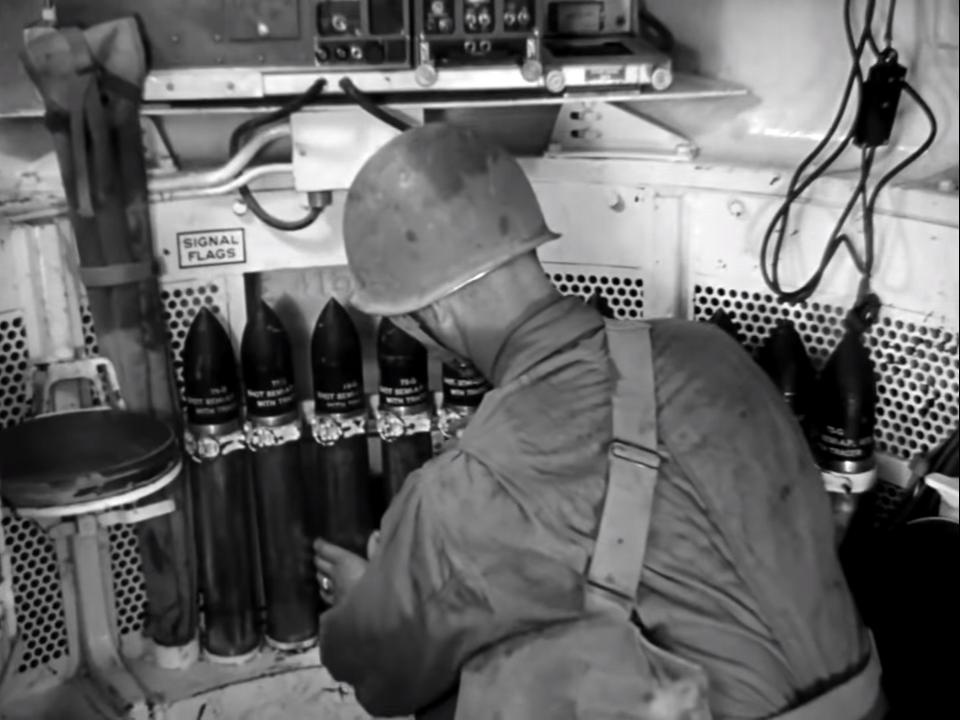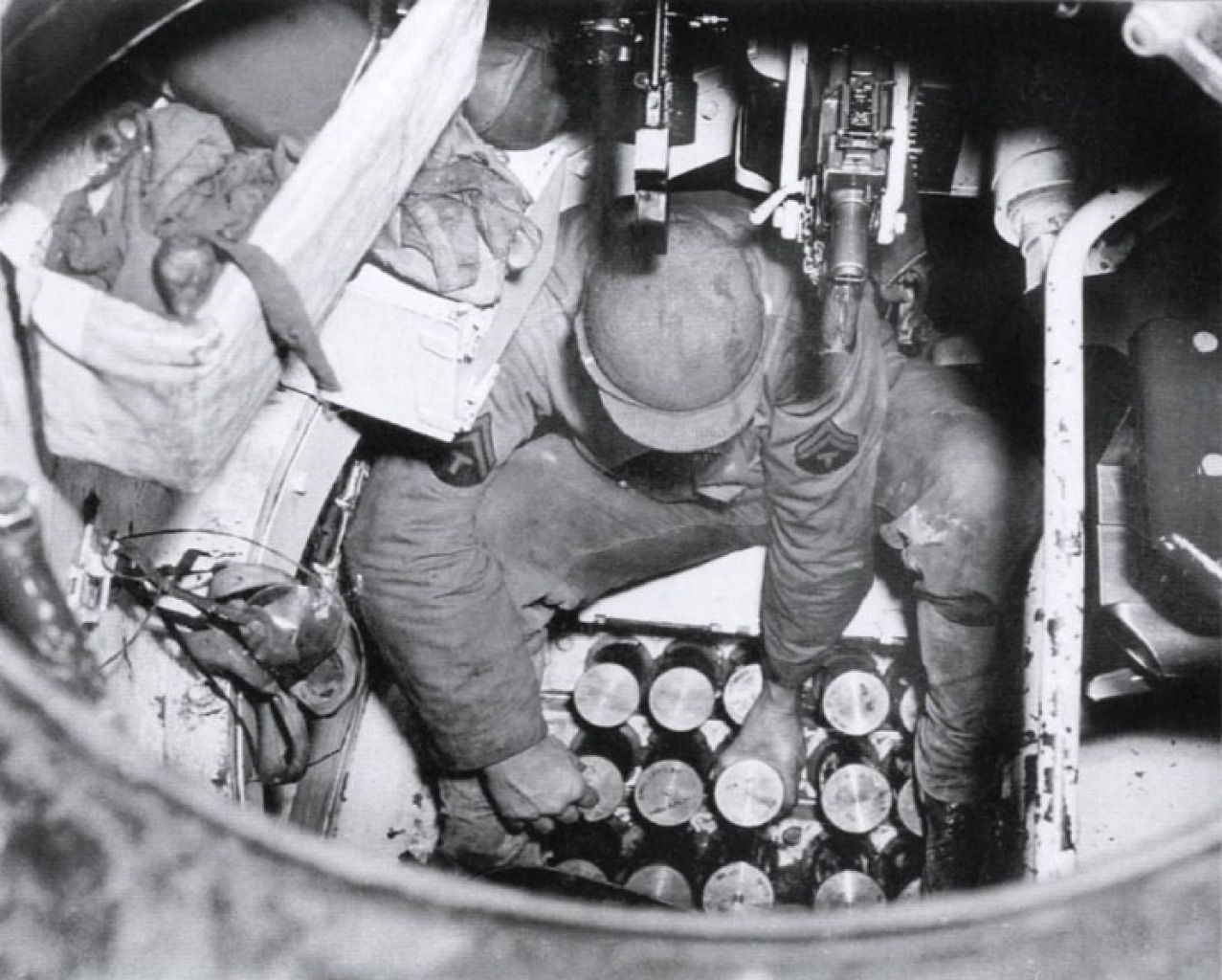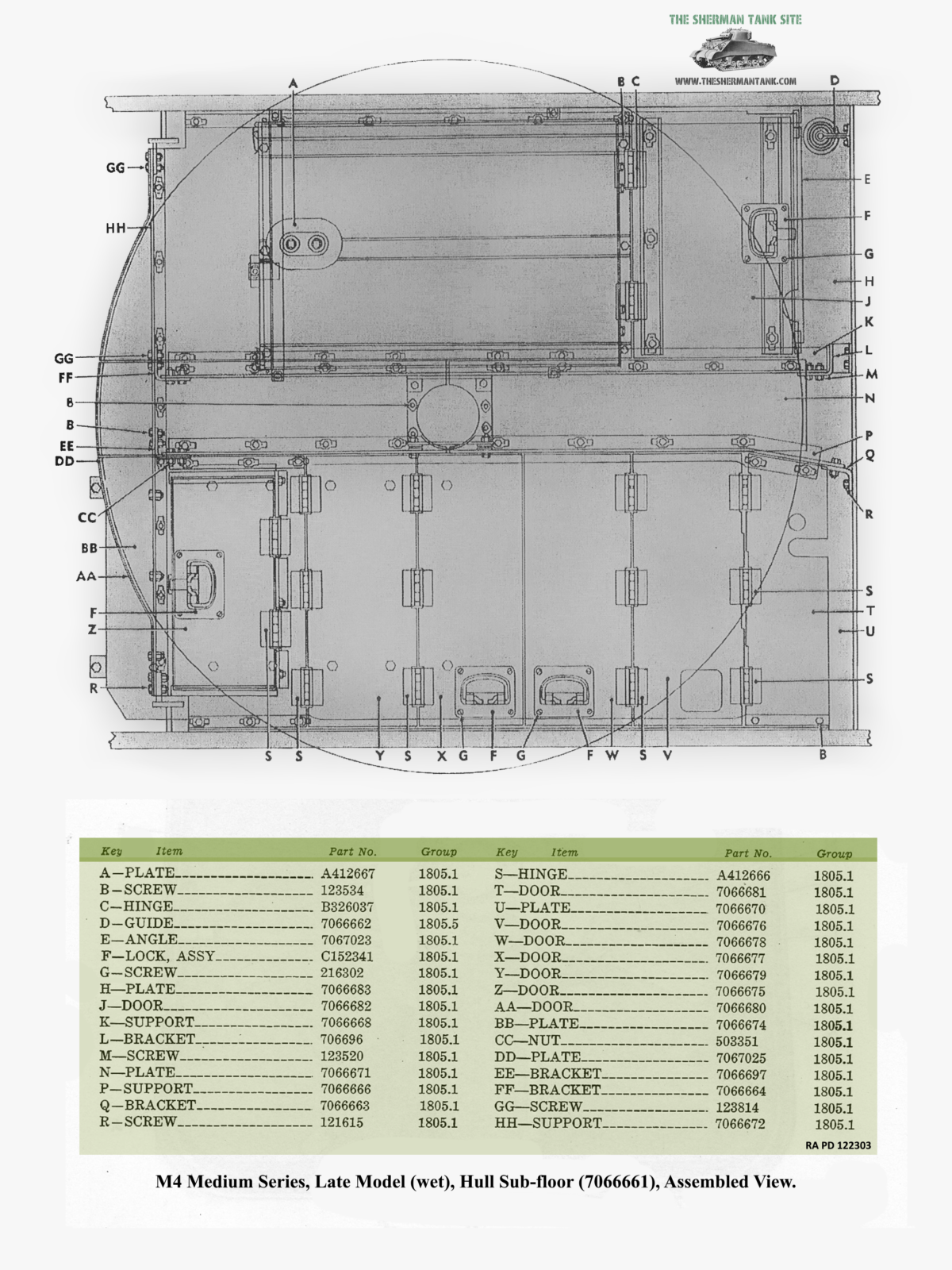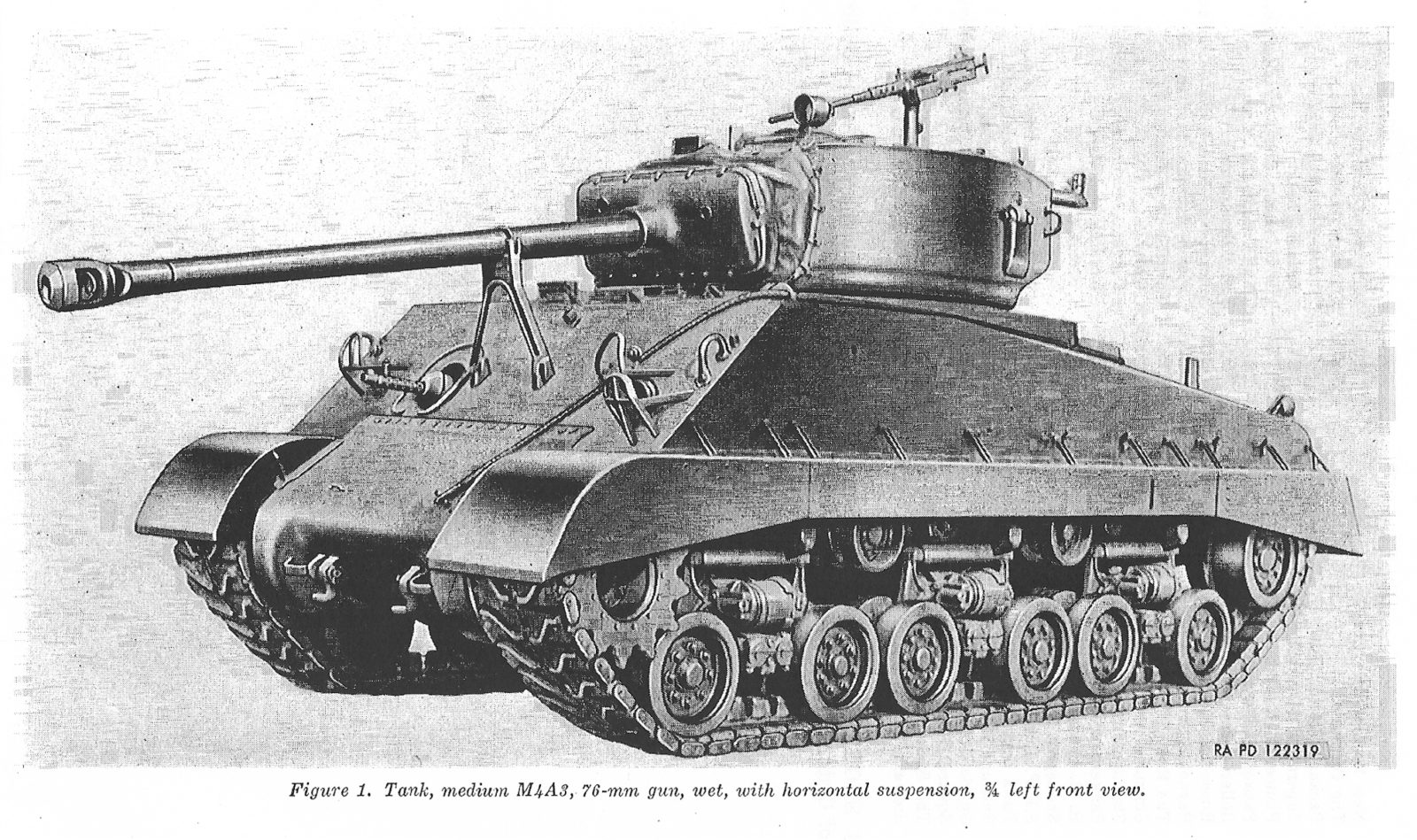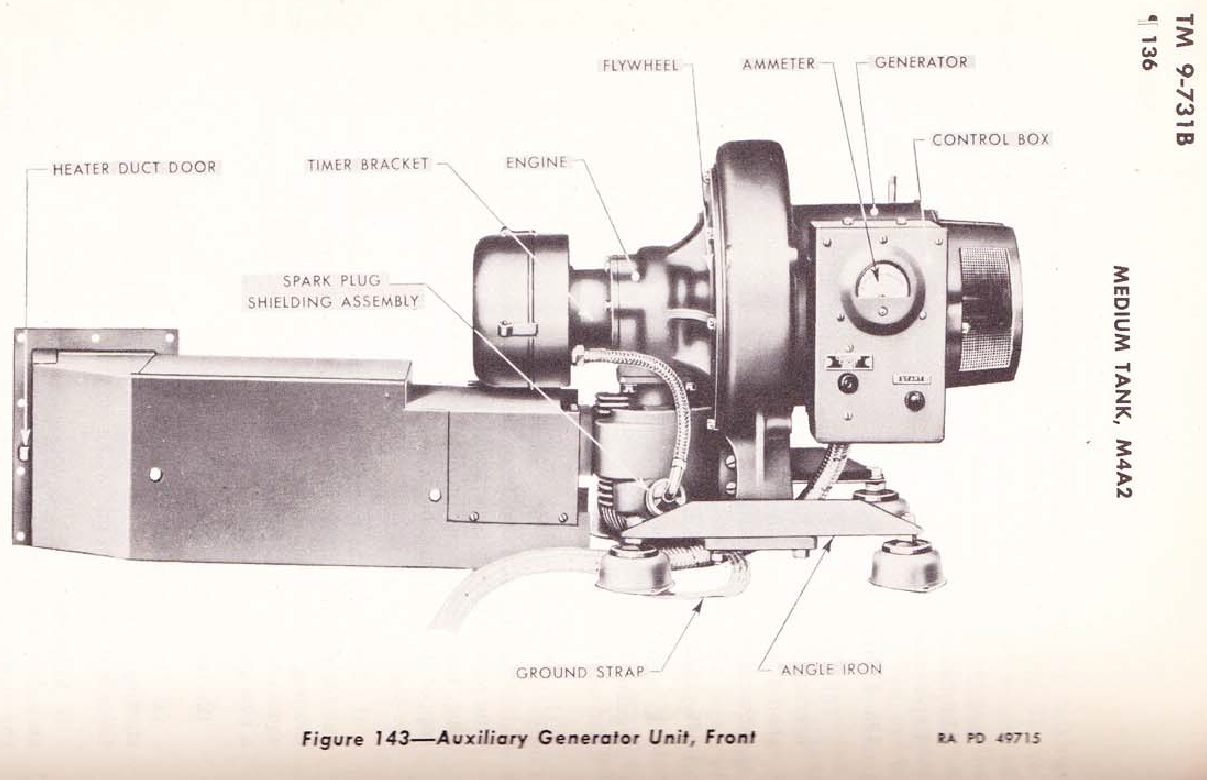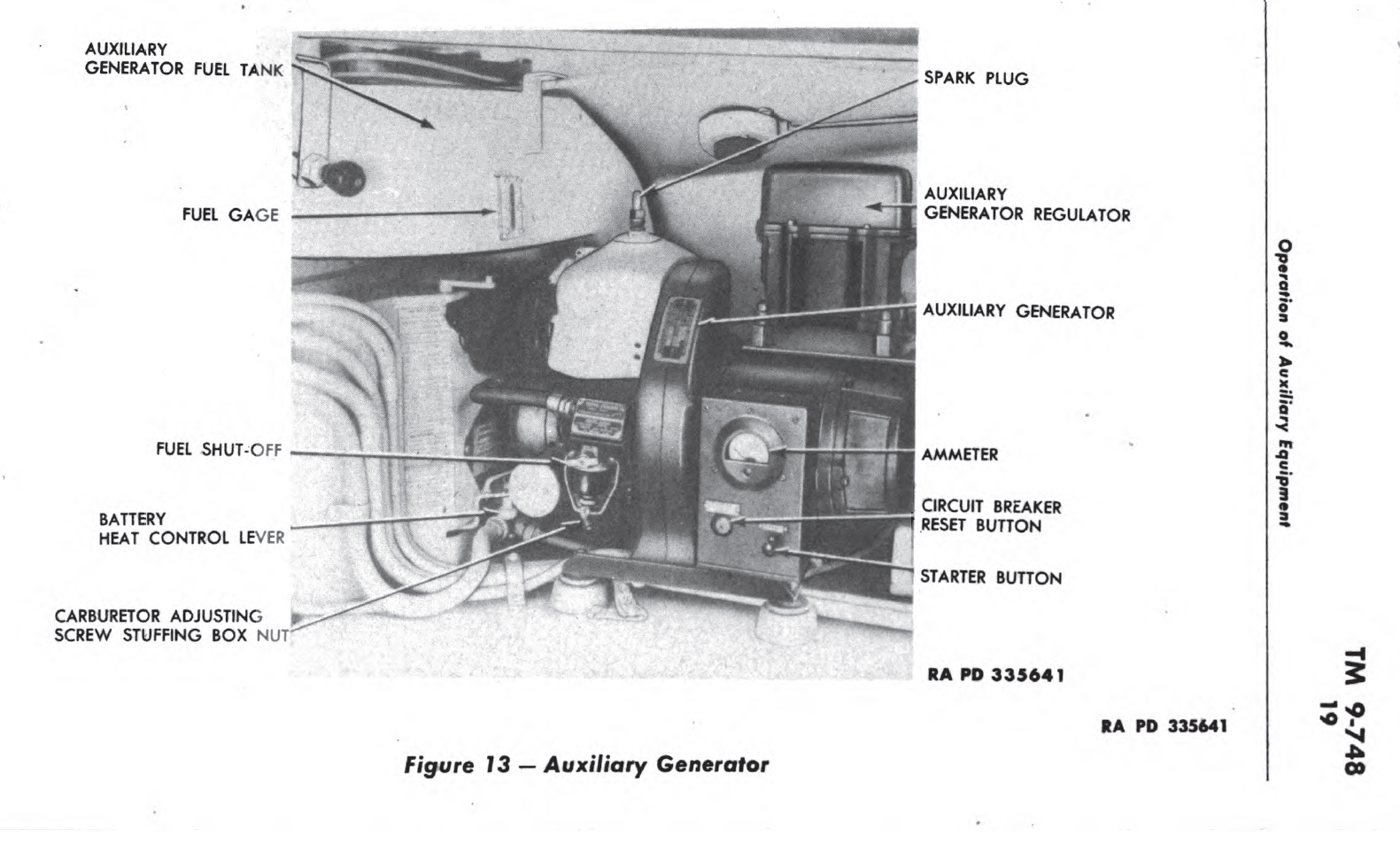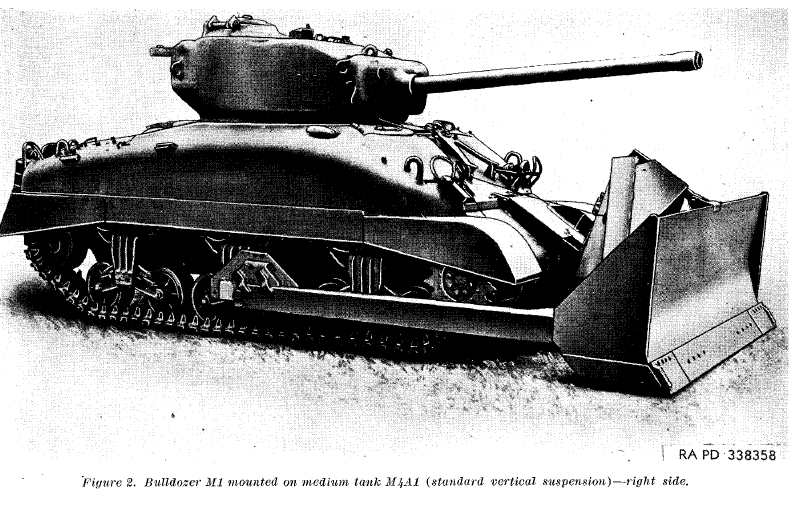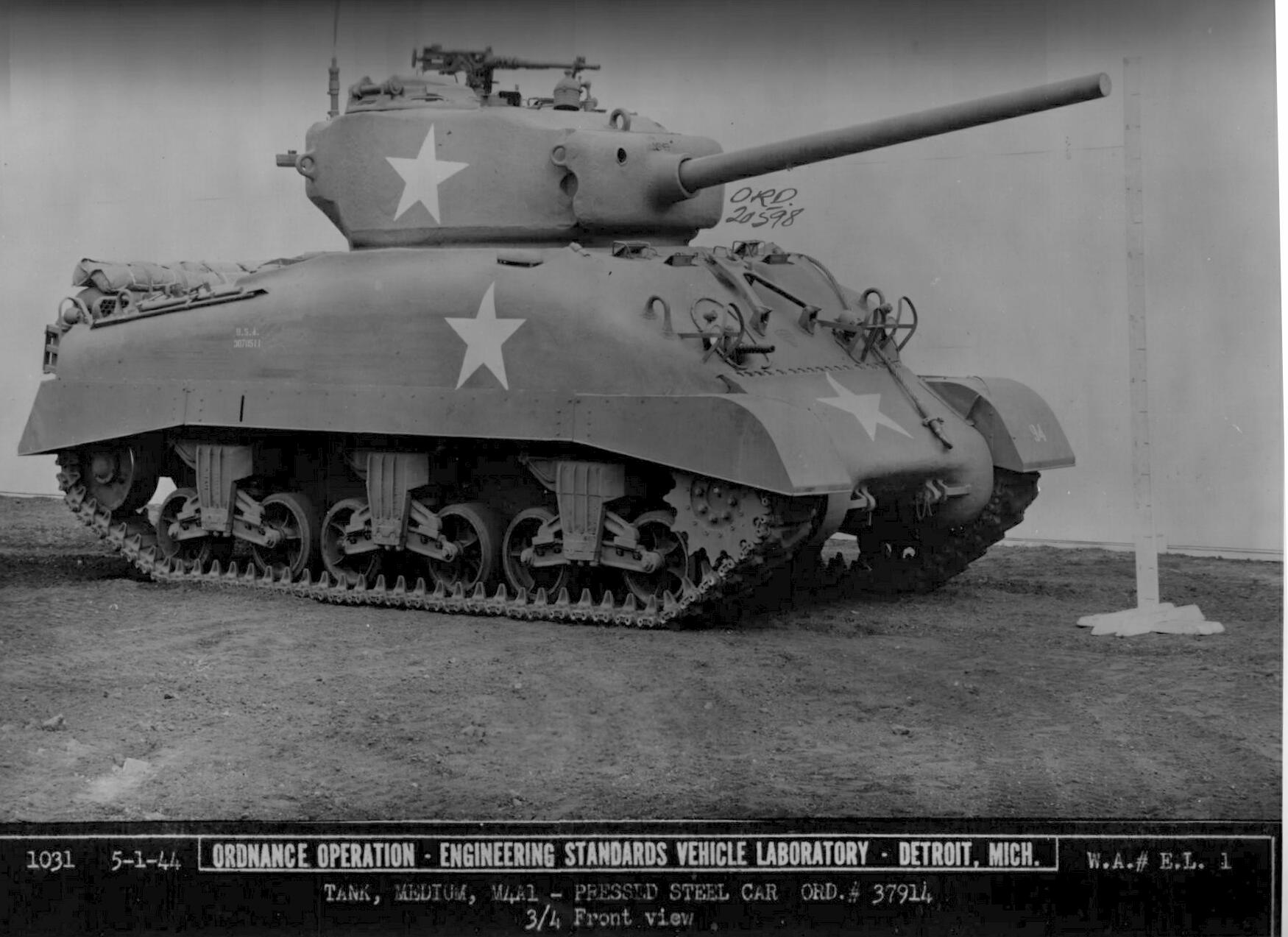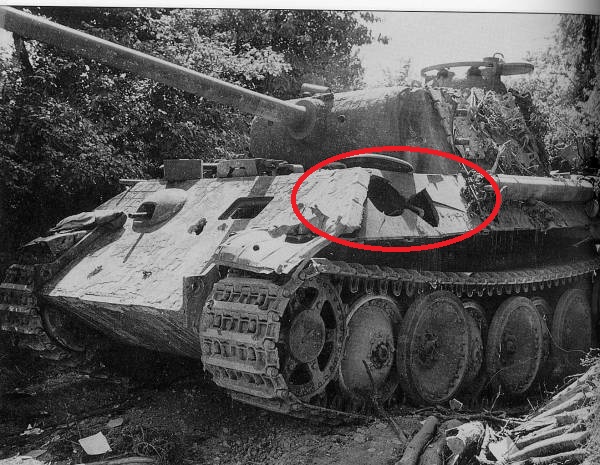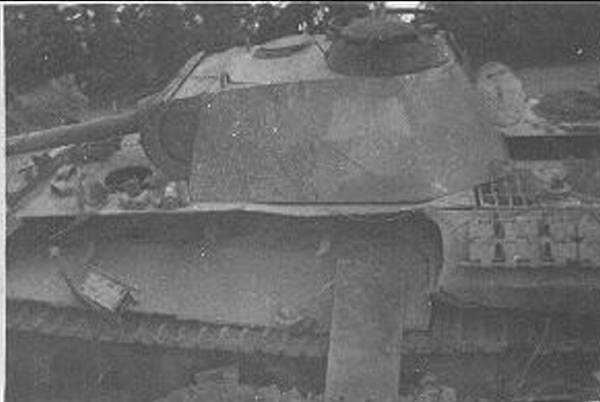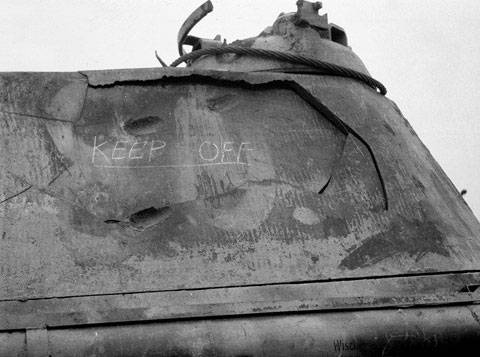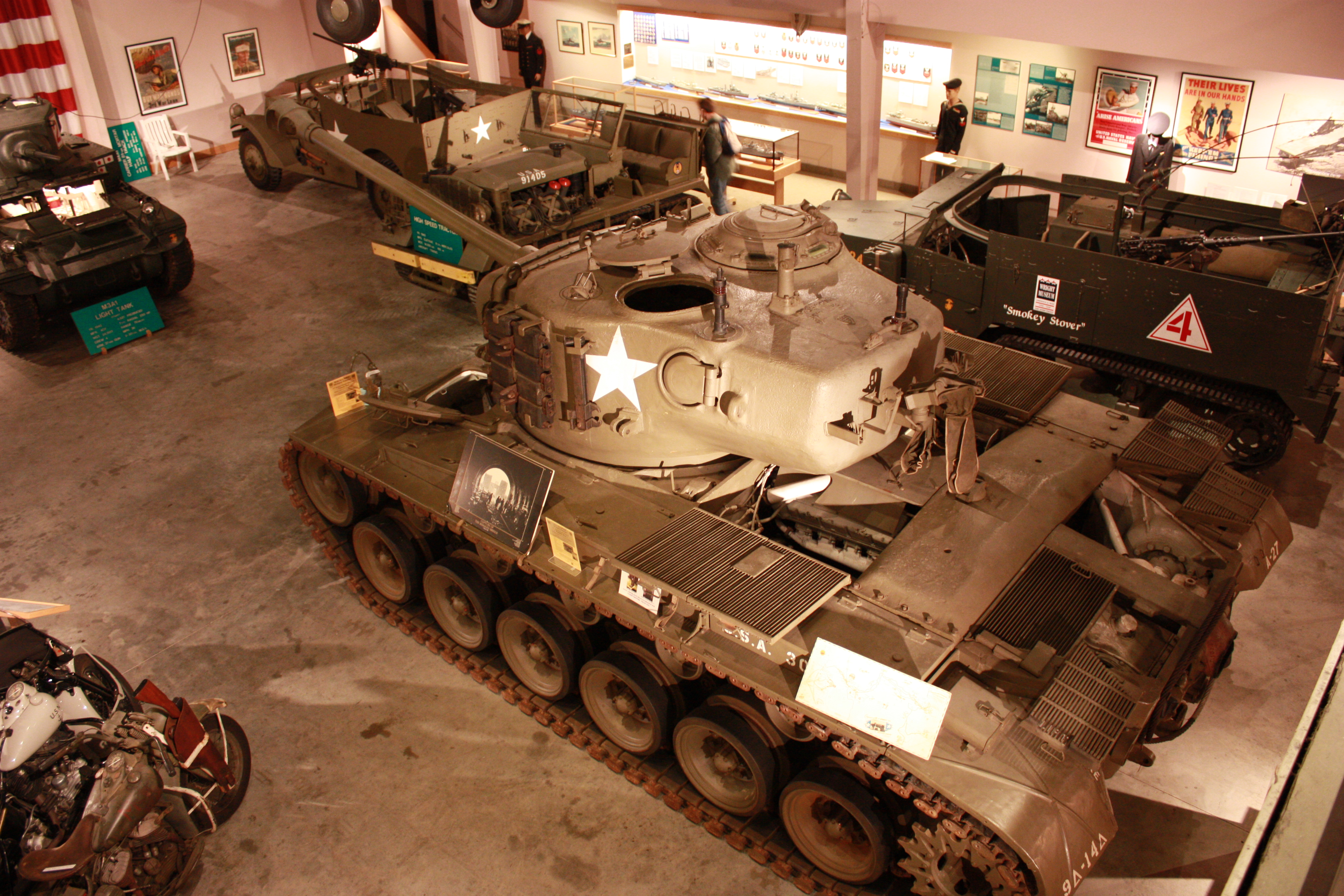Silly Myths: Things You Don’t Want to Say, At a Cocktail Party, or Clam Bake.
♠The Sherman was gas powered and a fire trap, German tanks had diesels, and they called it a Ronson.♠
As we know from this web page, or just about any current book on the Sherman, not all Shermans were gas powered. We also know the Sherman was no more prone to fire than any other tank, including German tanks and the Panzer IV and Panther both had reputations for burning as well. We know that the Sherman when it did burn, the fire was most often caused by an ammunition fire, and not fuel fires.
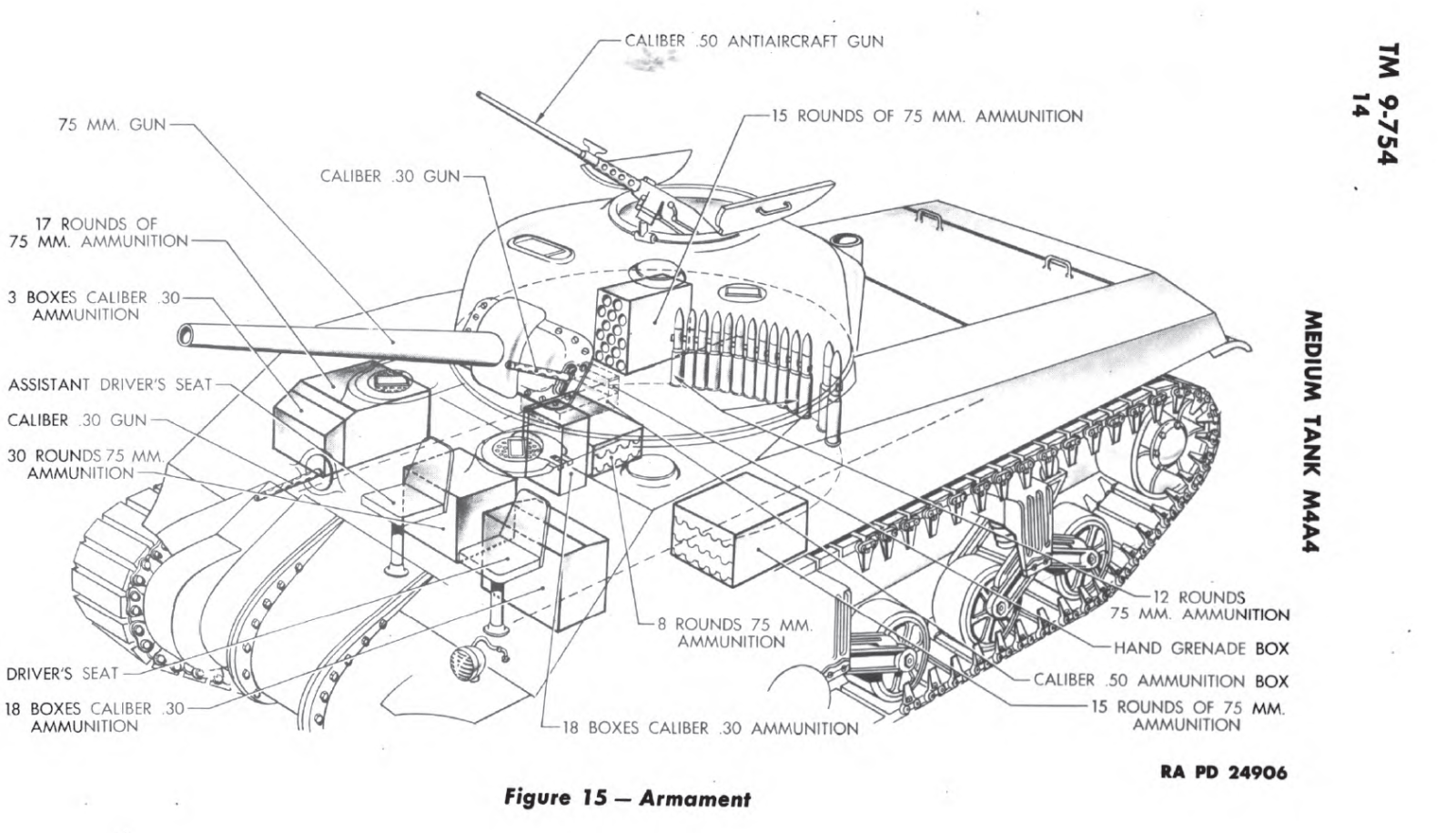 This was partially solved by adding armor to the ammo racks and removing the ready rounds stored around the side wall of the turret,(see image to the right and below) and adding an armored ready rack to the turret floor.It was solved by moving all the ammo to the hull floor, and adding water jackets to the ammo racks making the Sherman the least prone to burn tank of the war. We should also know that all German tanks were gas powered as well, and very prone to ammo rack fires, and in many cases, gas fires caused by poor designs, and horrid quality control, and slave labor factory workers. Early Panthers were so prone to fire, they tended to catch on fire just getting off train cars, or going over terrain that tilted the hull.
This was partially solved by adding armor to the ammo racks and removing the ready rounds stored around the side wall of the turret,(see image to the right and below) and adding an armored ready rack to the turret floor.It was solved by moving all the ammo to the hull floor, and adding water jackets to the ammo racks making the Sherman the least prone to burn tank of the war. We should also know that all German tanks were gas powered as well, and very prone to ammo rack fires, and in many cases, gas fires caused by poor designs, and horrid quality control, and slave labor factory workers. Early Panthers were so prone to fire, they tended to catch on fire just getting off train cars, or going over terrain that tilted the hull.
After several searches by different people, no one has been able to find an add from the Ronson company that uses the Lights the First Time, Every Time phrase, see this thread, and this thread the original that spawned it. You can find some info here too. They have many links to period and newer advertisements, but no Ronson ads even came close. So far, no one has been able to produce wartime documentation of that saying actually being used. Some flamethrower equipped Shermans were called “Zippos”, but because of the flamethrower, not for a tendency to ignite. There was also a British Flamethrower named a Ronson, so that may have added to the post-war, poorly documented history that started it.
As far as I can tell, this nickname really seems to stem from a one pop history book, and a bad docudrama on the history channel that stars the man most responsible for the Sherman’s PR problem, Belton Cooper. He, along with the tabletop Wargame makers of the 60, 70 and 80s really cemented this misinformation into popular culture. This coupled with several Hollywood films like Patton, Kelly’s Heroes, and The Battle of the Bulge, the Sherman had taken a serious hit on its war-winning reputation. Even some big name historians included the slogan in their works, even while trying to repair the tanks soiled reputation. It is possible it was called a Ronson or Zippo during the war in a widespread way, but so far, no one, even when challenged has been able to find any solid proof. The people who really get stuck on this one have a hard time giving it up because it accounts for a big chunk of what they call evidence for the Sherman being a bad tank.
It’s well-known soldiers bitch, and often suffer from grass is greener syndrome, but I’ve read more accounts of the men who used the Sherman loving them, it may be conditional, or not without complaint, but it’s really hard to find an actual tanker that hated the Sherman. When your Sherman happens to bounce a few rounds off a Panthers frontal armor before another Sherman took it through its thin side or turret side armor, it’s going to be disconcerting, what the Chieftain of the WOT forums calls a significant emotional event, and these things can shake your confidence in your tank, in particular, if your new to the job, and or don’t know all the problems the Germans crews had to deal with to keep their tracks fighting.
If crews complaining about their gear, actually makes it bad in all cases, then there are very few items of military gear considered good. I know there are several videos out there of WWII vets talking about the Sherman having thin armor and being a death trap, but in many cases, these guys were not even tankers. I’ve read many accounts of Sherman crews loving their tanks. They knew that tank was a hell of a lot safer in most conditions than having to be outside it fighting on foot. Many of these men have a deep affection for the Sherman, and there are pictures of these men crying when they see one again.
The Sherman tank had its share of flaws, and the Army and the guys who designed it worked very hard to improve the design throughout the war, and they did well, the late war Shermans were great tanks. In retrospect, a better gun was the only big design flaw you can pin down as a serious problem. Even so, the war would not have changed much if the Army had forgone development of a new gun for the Sherman the whole war, and it would probably have only cost a few more lives. Especially in the final days of the war in Europe, the 75mm gunned Sherman was an effective weapon against infantry and soft targets. More so than the 76mm armed Shermans, and was only exceeded by the 105 tanks, since German armor was so rare, and the main threat to tanks was panzerfaust, Panzerschreck, and AT guns, the 75mm armed Sherman may have been more effective and shortened the war. That said, a 90mm armed Sherman would have been RAD!
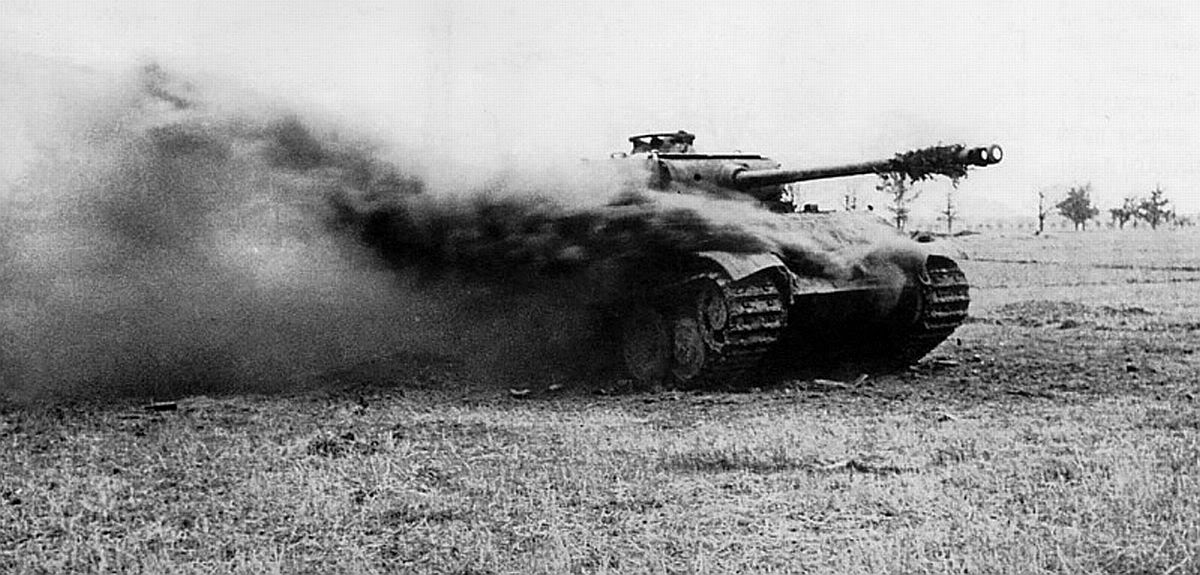
The Only Shermans to come with HVSS suspension had 76mm M1A1 guns.
As has been mentioned in this very document, HVSS suspension was pretty common on M4A3 75 W tanks produced in 1944. Several hundred if not thousand got HVSS suspension. We also know the M4 105 was produced with HVSS, as was the M4A3 105. This can all be confirmed by the wonderful Sherman Minutia site.
But lets prove it wrong with a pic. 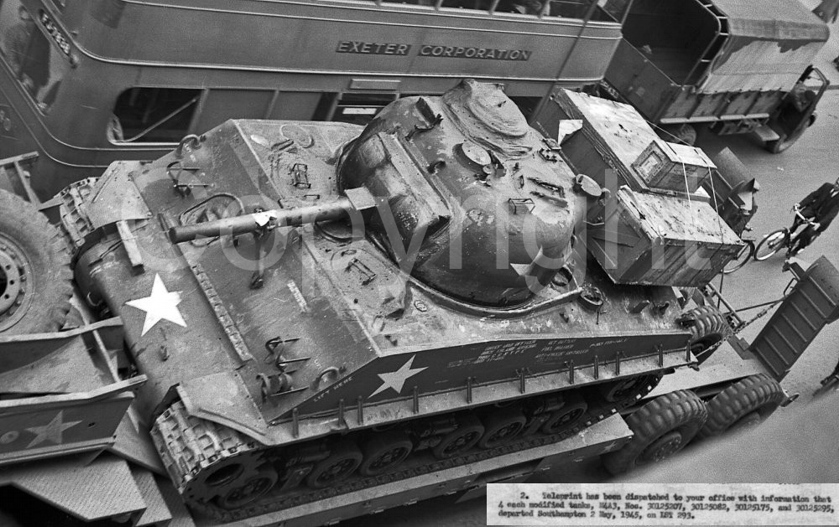
The Sherman was made to be basic, cheap and easy to produce, and not to last. They were not high-quality vehicles and had to depend on numbers to win.
This simply is not true. The Sherman was an advanced tank for its time. It incorporated a gyro-stabilized gun, a full set of advanced FM radios(the most advanced tank radios in the world, and a generation ahead of the German junk), and an auxiliary motor for charging the batteries, and sloped armor. The design could use either a cast or welded upper hull, without changing the other parts, and that’s pretty amazing considering the tank was designed with slide rulers. Every part of the Sherman was well produced, finished, and reliable in its dimensions. The design with minor modification could accept 5 different motors. The design had five reliable motors to choose from, and even the worst was more reliable than German motors.
The design tolerances were so close, parts manufactured at any factory, would work on any Sherman. That may not sound like a big deal, but at the time it was. The Germans could not produce tanks in the same way, and this was a huge advantage for the allied tank forces. Many of their tanks required hand fitting of parts. The early Shermans were all finely fitted, with beveled edges on the armor plate and all castings finely machined. The interiors included cushions for crew comfort and each crewman had at least one periscope. The huge castings used to make the upper hull of the M4A1 were a technological feat as well and not reproducible by any of the Axis nations. This was not the only part of the M4 they could not reproduce, the all-aluminum GAA V8 was a technological powerhouse, they could not have copied and not only because they didn’t have the aluminum. It was all the precise gears found throughout the motor, and don’t think they could copy the 6046 or A-57 either! But wait, that’s not all, let’s not forget the stabilized gun, something the Germans were not able to copy during the war. You can also make the argument the reliable and powerful hydroelectric turret drive system was beyond them, as was the all-electric alternate system that could be found in some production runs.
The Sherman was certainly not built to be easily worn-out and replaced. One of the reasons the basic 75mm M3 was chosen was because it had a 1000 round or more barrel life. All the motors were good for more than 5000 miles. The transmissions and final drives more than that, and that’s miles, not kilometers, like with the Panthers 150 kilometer final drives or 1500 kilometer transmission or 2500(lol maybe, I’m being nice) kilometers on the motor. You could get up to 2500 miles on most of the track models the Sherman used. The road wheels were easily replaced and rebuilt, and the springs in Shermans are holding up fine to this day on most of the ones still sitting around. The Brits put 2500 miles on M4A4 in a single test if I recall right, 10,000 miles on most of the motors in the A57 wouldn’t be impossible if no one was blowing the tanks up. `
For such a reliable tank, it was designed with ease of maintenance in mind and it was relatively easy to swap out the motor or transmission/final drive. The suspension units bolted on, so replacing one damaged beyond repair was very easy, or easy by tanker standards. Everything had grease fittings, and most were easy to reach. All the bearings were of the rebuildable or replaceable type. High-quality ball or roller bearings were used throughout the drivetrain and motors. There were often two generators powered off the drive train and or motor, and the auxiliary generator with its own motor.
These tanks also took upgrades well, being up-gunned with guns up to 122mm, and re-engine with more modern motors. The French and Israelis did most of the work in this area and these tanks will be covered in their own section. The point is, no other basic tank chassis lived as long as the Sherman did, with some South American nations keeping theirs in use well into the 80s or later since a few have recently been reactivated for training use. This same tank design was easily adapted into civilian uses as well, something I don’t think many other designs can claim with Shermans being used in construction, logging and drilling and a few other industries.
Cheap tanks rust away, they don’t run for decades, often on the same drivetrain parts. Complicated poorly engineered tanks like the panther or tiger are still around, most locked away in a museum in non-running condition. A few of those museums bring out the German monsters every once in a while, and drive them a few hundred meters, maybe more for the more reliable Tiger I design, and then store them away, praying they get enough in donations to keep the German steel monster running after the damage done that year by running and driving the damn thing. The Shermans at those museums start right up, run, get used in movies, and then get put back on display without the drama and worry that it won’t start up the next time or if it doesn’t it won’t be impossibly expensive to fix. There are a few rich men who own a running Panther, or some other German Tank, but they are rare, and the tanks are in many ways better than new, and still probably won’t make it past 150 kilometers before they have to overhaul the final drives. There are a hell of a lot more well-off men that own Shermans and can afford to drive them around whenever they feel like it.
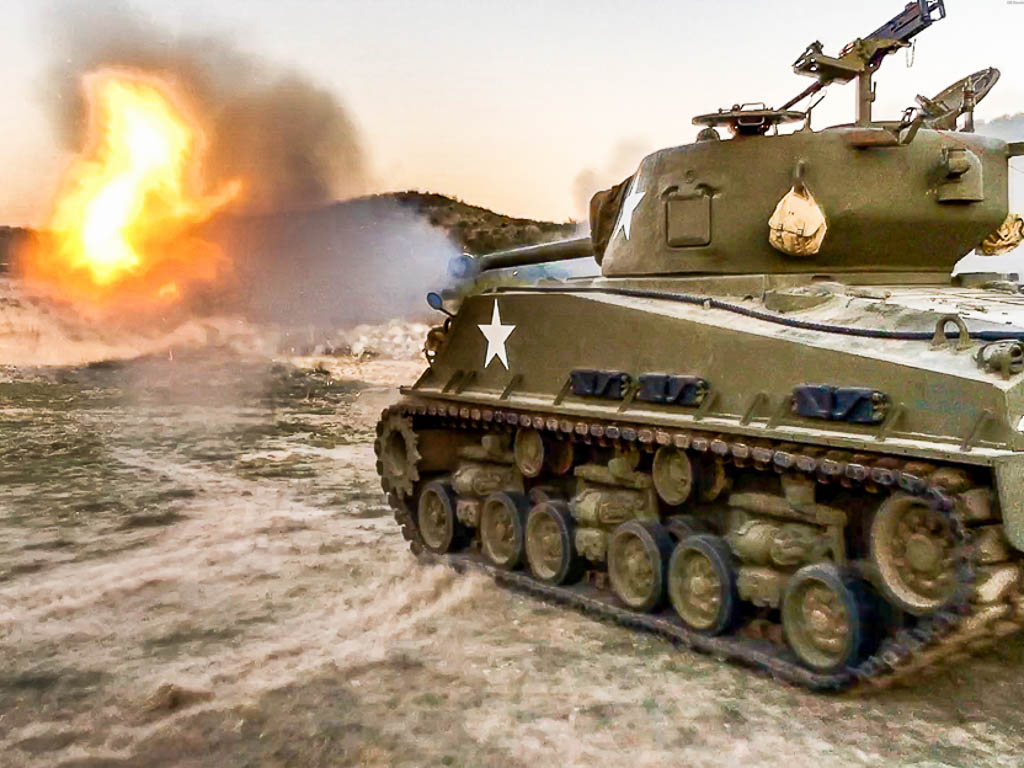
US tank production wasn’t optimized, and their supply system was overburdened by the number of different subtypes of tanks they used. With the Sherman, in particular, using four different power packs.
This myth is absurd. The main reason the United States produced Shermans with four different power packs, was they thought the bottleneck in producing the tank in great numbers would be outstripping of the supply of R975 radial engines. That never really happened, in part because the Army had three other viable engines, and produced them all. They were able to keep this from complicating the supply situation too much by limiting who got what models, with the US Army using a version with the R975, the Brits using the diesel and A57 multibank, and the Russians getting only M4A2s variants. They had enough surplus production in R975 production; they built a factory for the M7, another tank that would have used the motor, and one for the M18 that also used it. The M7 was canceled but a lot of M18s got produced.
This diverse Sherman production never hurt tank production speed in any way, and since the continental US was damage free, shipping parts between factories was easy enough. The US had a massive rail system and was still producing locomotives. When the Army started to move to the M4A3 as its primary tank they released more M4 and M4A1 tanks to their allies. The US actually had a tank production surplus for a short time and was able to close down all but the best three tank producers. Hell, they even built a factory to produce the M7 medium tank and then never built it. These are the types of errors you can make when your country is an untouched industrial powerhouse.
The only reason you can say tank production wasn’t optimized is because it was never maximized after the first panicky year of the war. This wasn’t because it couldn’t have been increased, or any production problems, it was from the US war production board looking at tank needs and deciding we had more capacity than needed and cutting it back. The US produced tanks for just about everyone and could have produced more if there had been more nations that needed them.
The US by the end of the war had three things the Germans never had, tank arsenals, factories produced from scratch, for the sole purpose of producing tanks from start to finish, with a production capacity the Germans could only dream of. In fact, CDA had contracts reduced before it ever got to full production capacity, and they were producing a lot of tanks. Three of them, letting them shut down tank production at all other factories so they could switch to other things
The 76mm armed Shermans were good, but they were like super rare, and not common until well into 45. Plus the extra weight of the 76mm turret made them slower, and like the gun blinded the crew when it was fired.
The levels of 76 armed tanks steadily increased after their introduction during Cobra. They went from a low of 6.7% in August of 44 to 30.1% in December, to 41% by April of 45. The extra weight did have a minor impact on off-road mobility, but duckbill end connectors helped and the increasingly common HVSS tanks after December of 44 solved this issue.
M4A1 76w Shermans were sitting in depots in England, on D-Day, because no one wanted to introduce a new vehicle at the last minute because there was no time to train on them, and no one saw an urgent need for them. Most of these tanks had the early M1A1 gun without a muzzle brake. There was a little truth to these tanks blinding themselves when the gun fired, in the dusty summer conditions it was introduced in, but once it started raining and snowing this issue faded, and also tanks with muzzle brakes started showing up.
Tanks like this were showing up by operation Cobra, by the battle of the Bulge they were nearing 30% of the US medium tanks in Europe. By the end of the war, the 76 armed Shermans were approaching 50%.
You know if you had to fight in a tank in WWII, you would want to be in a Tiger or Panther!
This is a very common argument or myth that comes from German Armor “fanboys” also known as the infamous ‘Wehraboo’, and they will sometimes be shocked if you say no, as if they thought the info about the Sherman being a better tank was all lies, and when faced with the ‘truth’ of combat you would have to choose their favorite German tank. This is a really silly argument, but a very common one, so I’ll cover it.
So first off, let’s go over the German side, one, no matter what tank choice I was given, I would not fight in or for Nazi Germany. Moral problems with German tanks set aside there still isn’t a Nazi tank I would want. The PIII is too limited and inferior to the Sherman in all ways, the PIV is inferior to Sherman 75 in all ways let alone the 76 armed Shermans. The Panther was unreliable junk, maybe if I really wanted to avoid combat, it might be a good choice, but it stands a good chance of killing you in a fire caused by its poorly designed fuel system or carburetors.
No, if I had any tank to pick from it would be the M26 Pershing. This tank made it to the war pretty late, so many German army “fans” will object cause it so little combat, but there were more M26s produced before the war’s end than Tiger IIs. They will also try and say it was an unreliable vehicle. The unreliable part gets played up too much on the M26, it’s real problem was it was underpowered.
The M26 Pershing would not have seen production if it had not met a basic level of automotive reliability the Army could find acceptable, the Army would not have started building it if it had not met basic reliability requirements in testing. It was not as reliable as the M4A3 because the design was not as old, and the engine was overburdened a design problem…
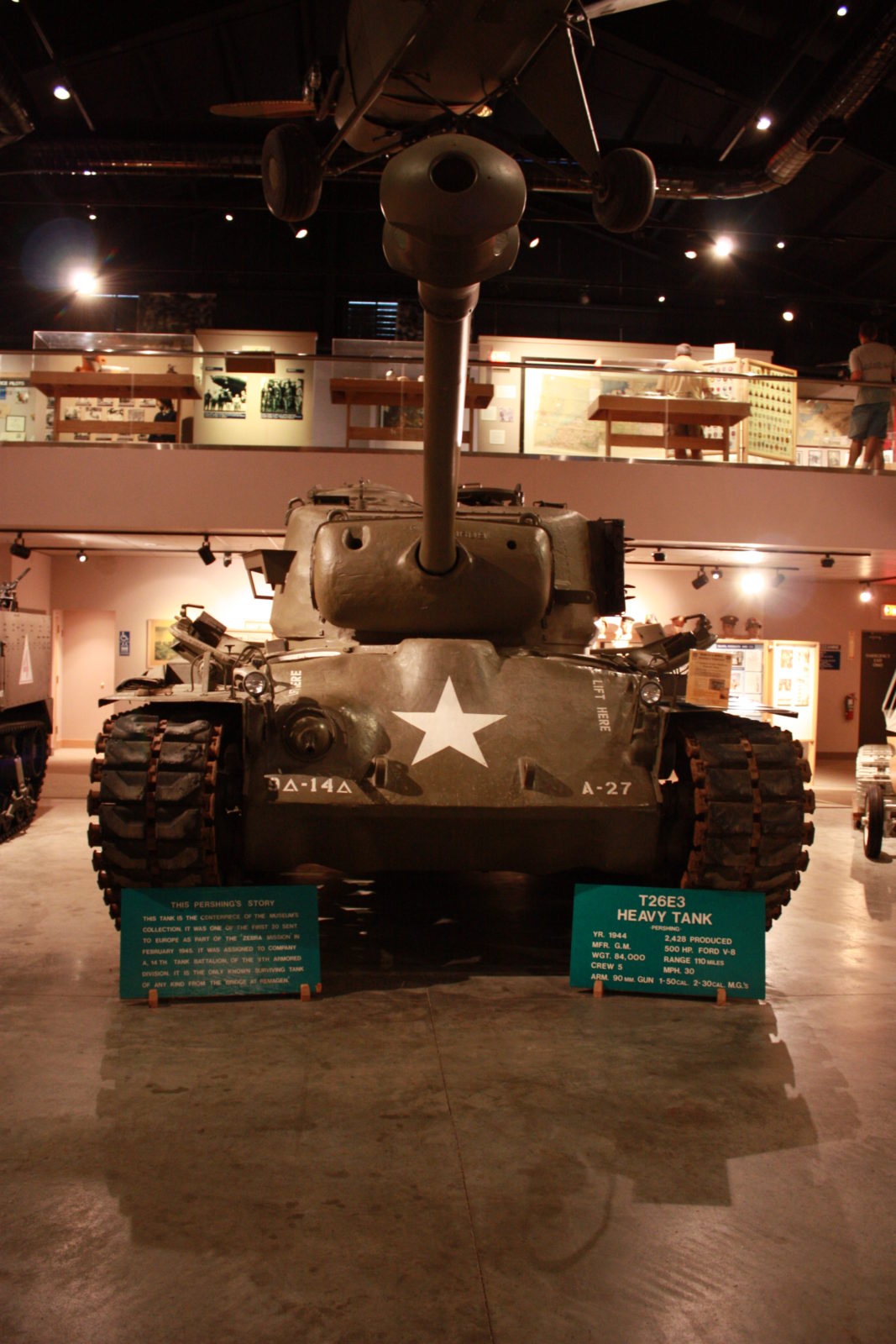
I’ve also read the Zebra mission tanks that made it over before the end of the war were lavishly supported and amazingly reliable. It had some issues in Korea, some caused by poor replacement parts or lack of them, and others from lack of skill on the driver’s part and lack of experience in the crews. At the beginning of the Korean War, when the Marines got issued M26 tanks for the first time they got less than two weeks to train on them. Like the panther, the Pershing had to be driven well, a jerky driver could cause fan belts to break or slip off the cooling fans overheating the motor. The Panthers problem was much worse, if the driver wasn’t smooth, he could destroy the final drives in the panther very quickly, if he used features of the vehicle he could destroy the transmission. Neither of these problems is as simple as putting the fan belts back on and adjusting them.
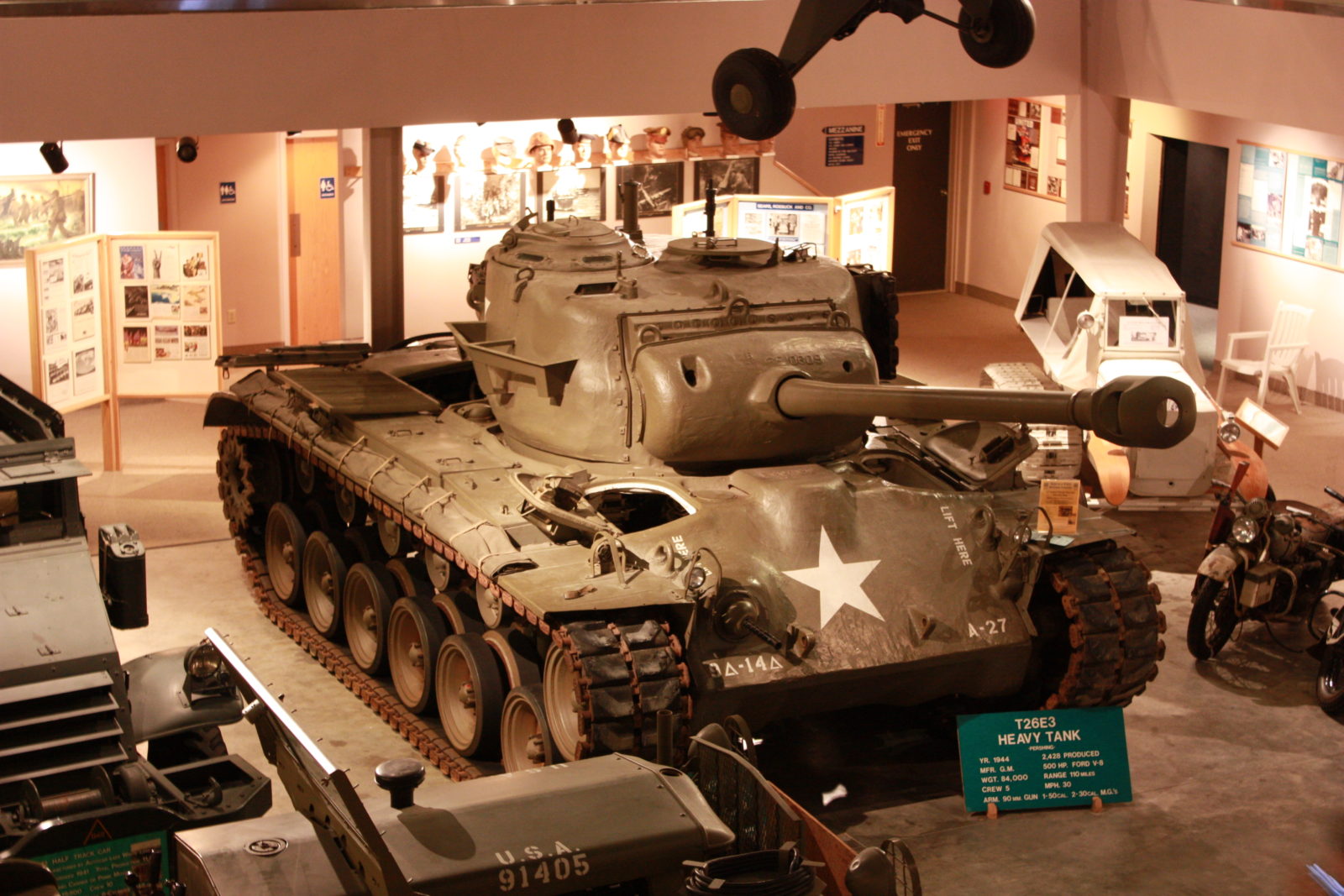
The M26 usually won’t be allowed by the ‘fan’, so my next choice would be an M4A3E8 76W tank. Because these were the best Shermans produced. They had a great motor for a tank in its weight range, and it had a decent gun, and ok armor. Its armor could be upgraded in several ways as well, as we’ve shown with sandbags, concrete or armor plate from other tanks. Because of the large hatches, the escape hatch, and the wet ammo racks, the late production Sherman was about the safest tank of the war to be in while it was being shot at. While in Pershing or E8, it would not be the poorly crewed, unreliable Panthers, or the mythical lottery tank, the Tiger, no, I would fear the German 75mm AT guns and really big mines, and crazy hardliner Nazi holdouts with AT sticks. Not the Cats.
Fun Facts: Stuff to make German Armor Fans Cry.
The M4A1 Sherman Was So Advanced In Design; The Germans Could Not Have Produced A Copy. (The M3A1 Lee as well)
Even if they had been given the blueprints. They simply lacked the technology to make a large casting like the whole upper hull of a tank. This type of casting was leading edge technology in the 1940s and the US was a world leader, the Germans, were not. They probably couldn’t even cast the standard 75mm turret.
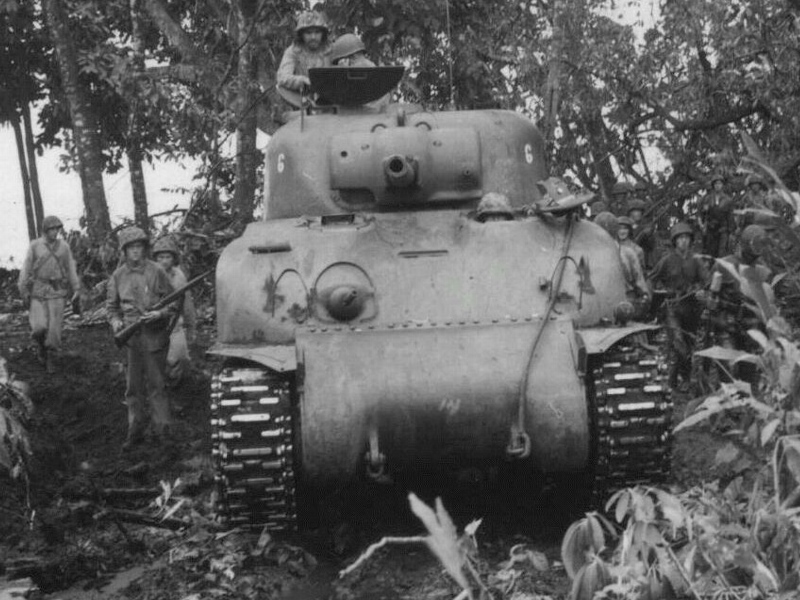
The Germans also had nothing like the gun Stabilization system the Sherman had, and the Lee also had for its 37mm gun. The Germans also had a lot of trouble producing tank engines in the 400 to 500 hp range that was reliable enough for tank use. The US had four to choose from.
The Germans liked the Sherman and T-34 so much they rebuilt any they captured and used them in combat.
It was not uncommon for the Germans to have whole tank units filled with captured and slightly reworked T-34s and M4A2 tanks. The Sherman would be a refreshing surprise on the reliability front, and probably as easy to keep running as their native PIII and PIV tanks. They had whole company size units made up from these captured tanks.
They also liked to convert these captured tanks into ARVs, since their native armor was such an automotive disaster and couldn’t take the added stress of recovering tanks. In the west, they also used captured allied tanks, and there are pictures of just about every model and submodel of Sherman with Nazi markings.
Nazi Germany never developed and deployed ‘Funny’ Tanks, no dozer blade kits, no mine clearing tanks, no floating tanks not even a good ARV.
There are several reasons for this. For dozer blade systems, their tank automotive systems were just not reliable enough to take the extra weight. The Shermans M1 Dozer kit added more than 7000 pounds to the tanks weight. This would have immediate failures on Panthers or PIV drivetrain if they tried to install similar kits. The Panzer III might have been able to take the extra weight, but the PIII had really gotten long in the tooth by 44.
For mine clearing, it was common practice for the Nazis to march Russian prisoner or civilians through minefields to clear them, so maybe a mine clearing vehicle wasn’t the top priority. I don’t think marching civilians or POWs across fields would set of AT mines, but maybe they did the same thing with civilians in cars or trucks? In any case, any mine clearing conversions would have to be very stripped down to take the added weight of any of the mine-clearing contraptions that have been tried over the years.
They did modify tanks for use as ARV, but used captured tanks, and never developed a good ARV on their own. The same automotive reliability problems that prevented the Germans from producing a tank dozer or any kind of a mine-clearing tank probably prevented them from using their own designs as ARVs as well. The Germans main tank recovery vehicles were large 18-ton half-tracks equipped with a bunch of special towing and recovery gear, and tank transporter trucks. With a good winch, some strong anchor points and pulleys, you can pull a lot of weight. They also used any captured ARVs, and would often modify a T-34 or Sherman for use as an ARV because these tanks were both reliable, and had automotive systems that could handle the extra wear and tear ARVs go through.
There is an exception, the Bergepather, a dedicated ARV based on the Panther chassis, which worked ok by Nazi standards. It did have many of the same problems the Panther had since it used the same drivetrain. Now, because it had the turret removed, it was much lighter, but it also had a big heavy PTO winch installed where the turret normally resided. It used the turret drive to power it, meaning the Panthers motor, for maximum pulling power, you’re running the Maybach at max RPM, and we all know how that goes. It was also designed for a wonky form of recovery, were it backs up the knocked out tank, hooks up its cable, then drives out the full length of the cable, lowers the spade, and slowly while straining the motor, drags the dead tank right back up to the rear of the Bergepanther and then this is repeated until it was out of the danger zone and could be loaded on a truck. It could also just hook up and tow a tank out if the terrain wasn’t too bad. It used a large wooden block as a pusher bar, instead of having the spade in the front, so it would be useful for more than just as a towing anchor, anyway, it used the same goofy overlapping wheels, with all the problems that came with them, for no advantage at all on an ARV. They did give it more fuel tanks, so it had a better range, and since it weighed slightly less, the automotive components had a chance of lasting a bit longer, but still not a great ARV.
For floating tanks, well, they tried deep fording tanks, and possibly even underwater ones, but never floating ones. In my opinion, without complete air superiority, and the quick capture of a large port, the Germans couldn’t take England. They are very close to mainland Europe, making the need for a huge number of ships slightly smaller, but really not much. Then you have to look at the German Navy, and ocean-going cargo capacity. They would lack all the specialized ships the Allies came up with the make amphibious landings viable. They had no huge transport fleet. No specialized LSD, no LSTs, no LCT, LCM, LCI, and not battleships or other capital ships worth a damn. For amphibious warfare, you need a real fleet, not a pair of overrated battleships and fat useless cruisers.
Sources: Armored Thunderbolt by Zaloga, Yeide’s The Tank Killers, The Infantry’s Armor, and Steel Victory, Sherman by Hunnicutt, Combat Lessons, The Rank and file, what they do and how they are doing it 1-7, and 9. Archive Awareness, Oscar Gilberts, Marine Tank Battles in the Pacific, WWII Armor, Ballistics and Gunnery by Bird and Livingston, Tigers in the Mud, by Carius, D.W. to Tiger I, and Tiger I & II combat tactics by Jentz, Panther Tank by Jentz, Panther and its Variants by Speilberger, Panzer III and its Variants and Panzer IV and its variants by Speilberger, The Sherman Minutia Site, Son of a Sherman by Stansell and Laughlin, M4 Sherman tank at war by Green, Tanks are a Might Fine Thing by Stout, the Lone Sentry, DOA Army Battle Casualties and Non Battle Deaths in WWII, FKSM 17-3-2 Armor in Battle, FM17-12 Tank Gunnery, FM17-15 Combat Practice firing, FM17-30 The Tank Platoon 42, FM17-32 The Tank Company medium and light, FM17-33 The Armored Battalion, FM17-67 Crew Drill and Service of the Piece M4 Series, Another River, another town by Irwin, Tanks on the Beaches by Estes and Neiman, Cutthroats by Dick, The Myth of the Eastern Front by Smelser and Davies, Tank Tactics by Jarymowycz, Panzer Aces by Kurowski, Commanding the Red Army’s Shermans by Loza, The French Panther user report, Wargaming’s Operation Think Tank Videos .
